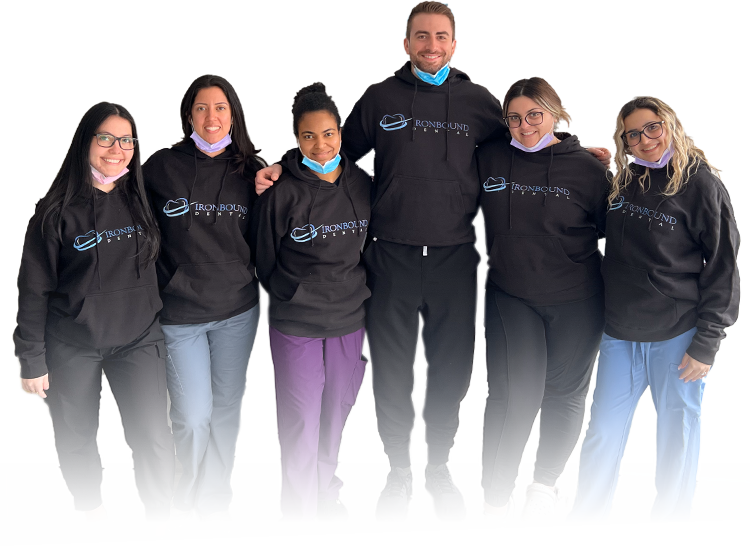Ironbound Dental Center
Oral & Maxillofacial Surgery

Oral & Maxillofacial Surgery
Oral & Maxillofacial Surgeons are specialists with advanced training and expertise in the diagnosis and treatment of various head and neck conditions and injuries. After four years of dental school, an Oral & Maxillofacial Surgeon completes four to six years of additional formal training in treating the craniomaxillofacial complex. This specialty is one of 9 dental specialties recognized internationally and by the American Dental Association (ADA).
An Oral Maxillofacial Surgeon can diagnose and treat a wide variety conditions. The following are just some of the many conditions, treatments and procedures oral and maxillofacial surgeon deal with on a daily basis:
- Laser Frenectomy
- Crown lengthening
- Dental implants
- Bone grafting
- Surgical extractions
- Biopsy
- Impacted Wisdom Teeth
- Cosmetic crown lengthening
Related Procedures
Third molars, commonly referred to as wisdom teeth, are usually the last four of 32 teeth to erupt (surface) in the mouth, generally making their appearance between the ages of 17 to 25. They are located at the back of the mouth (top and bottom), near the entrance to the throat. The term “wisdom” stems from the idea that the molars surface at a time typically associated with increased maturity or “wisdom”.
In most cases, inadequate space in the mouth does not allow the wisdom teeth to erupt properly and become fully functional. When this happens, the tooth can become impacted (stuck) in an undesirable or potentially harmful position. If left untreated, impacted wisdom teeth can contribute to infection, damage to other teeth, and possibly cysts or tumors.
There are several types, or degrees, of impaction based on the actual depth of the teeth within the jaw:
Soft Tissue Impaction: The upper portion of the tooth (the crown) has penetrated through the bone, but the gingiva (gum) is covering part or all of the tooth’s crown and has not positioned properly around the tooth. Because it is difficult to keep the area clean, food can become trapped below the gum and cause an infection and/or tooth decay, resulting in pain and swelling.
Partial Bony Impaction: The tooth has partially erupted, but a portion of the crown remains submerged below the gum and surrounding jawbone. Again, because it is difficult to keep the area clean, infection will commonly occur.
Complete Bony Impaction: The tooth is completely encased by jawbone. This will require more complex removal techniques.
If you are experiencing extreme sensitivity or are suffering from advanced periodontal disease, you may be required to have a tooth extracted. With a simple extraction, the dentist can safely remove the affected tooth without the need for major surgery.
Reasons for a tooth extraction
There are numerous situations in which a simple extraction can help alleviate pain or prepare you for another cosmetic or restorative procedure. Some common reasons for extraction include:
- Advanced periodontal disease that has loosened the tooth roots
- Extra teeth or baby teeth that impede adult teeth
- Preparing a patient for orthodontic treatment
- Removing a fractured or malformed tooth
- Severe tooth decay which cannot be remedied with root canal therapy
Sleep apnea is a serious, sometimes fatal medical disorder that affects around 10% of American men over the age of 40, and 6% of American women of the same age. Sleep apnea sufferers completely stop breathing during sleep, sometimes hundreds of times in a single night. Normal breathing ceases because the airway becomes obstructed, causing a serious reduction of airflow to the lungs.
There are a number of dental devices that can be used to alleviate this condition. The goal of most of these devices is to separate the jaws and push them forward slightly. This slight repositioning opens up the airway, and allows oxygen to flow freely again. Wearers of sleep apnea dental devices report that they stop loud snoring, feel more rested in the daytime, and are much more comfortable going to sleep. Sleep apnea appliances work best on patients who are not significantly overweight. They offer a viable alternative to Continuous Positive Airway Pressure (CPAP).
Temporomandibular joint disorders (TMJD or TMJ), are notoriously difficult to diagnose and treat. Many of the related symptoms, such as headaches and earaches, often lead doctors to diagnose a sinus condition, as opposed to a problem with the jaw joint. TMJ symptoms often change in severity, depending on how much stress the sufferer is experiencing. During an intensely stressful period, grinding teeth, debilitating earaches, and lockjaw may occur. Botox® injections are sometimes an effective and painless way to alleviate tension in the temporomandibular joint, reducing jaw pain, headaches, and suffering.
Botox® is commonly associated with cosmetic practices, including eliminating glabellar lines and facial wrinkles. Recently however, Botox® has become an increasingly popular TMJ treatment. Although some TMJ symptoms may improve without any specific treatment, Botox® offers fast and long-lasting relief for those that do not.
Here are several of the major benefits Botox® offers TMJ sufferers:
- Elimination of headaches caused by nighttime grinding.
- Minimization of lockjaw.
- Reduced discomfort when using the jaw.
- Reduced shoulder and neck pain.
- Substantially reduced jaw tension.
The teeth are held firmly in place by strong roots that extend into the jawbone. Molars and premolars tend to have several roots, whereas the front incisors only have a single root. The end or tip of each root is termed the apex. The apex is where the nerves and blood vessels enter the tooth, and aids in the delivery of blood to the crown (the part of the tooth you can see in your mouth).
A root canal treatment refers to the cleaning of the canals and the removal of infected and inflamed tissue within the root. When the inflammation or infection persists after the root canal treatment, an apicoectomy may be required. An apicoectomy is essentially the removal of the apex (or root tip), followed by a filling procedure to seal the root from further infection. When left untreated, infected roots can damage other teeth, spread infection, and cause regression of the jawbone.
Reasons for an apicoectomy
Infected and inflamed soft tissue around the root of a tooth can be exceptionally painful and debilitating to the patient. The purpose of an apicoectomy is to eliminate the infection in the tissue and to ultimately preserve the function of the tooth and save it from extraction. An apicoectomy will rarely be considered by the dentist unless a prior root canal treatment has failed.
There are several reasons why an apicoectomy may be necessary:
- Small Adjoining Root Branches – Roots are extremely complex and can contain many tiny branches. If these tiny branches cannot be cleaned and sealed when the root canal treatment is performed, inflammation can persist.
- Blocked Root Canal – In some cases, the dentist is unable to effectively clean a root canal because it is blocked by a fractured file left behind from prior root canal treatment. Infection and debris can quickly affect adjacent teeth.
- Narrow or Curved Root Canals – When the root canal is poorly shaped, the endodontic files cannot reach the root tip. Continuing infection or re-infection can then occur.
Cracked and fractured teeth are common dental problems. As people retain their natural teeth longer (due to advances in dental technology), the likelihood of cracked teeth increases. There are many reasons why teeth may crack, for example, biting on hard objects, trauma, grinding and clenching of teeth. All of these behaviors place the teeth under extra strain and render them more susceptible to cracking.
When tooth enamel is cracked, pain can become momentarily debilitating. When no pressure is exerted on the crack there may be no discomfort. However, as the cracked tooth performs a biting action, the crack widens. The pulp and inner workings of the tooth then become exposed, and painful irritation occurs. As pressure is released again, the two parts of the crack fuse back together, and pain subsides. If left untreated, the pulp becomes irreversibly damaged and constantly painful. The resulting pulp infection can affect the bone and soft tissue surrounding the tooth.
Symptoms of a cracked tooth may include:
- Unexplained pain when eating.
- Sensitivity to warm and cold foods.
- Pain with no obvious cause.
- Difficulty pinpointing the location of the pain.
Peace of Mind with Expert Care



